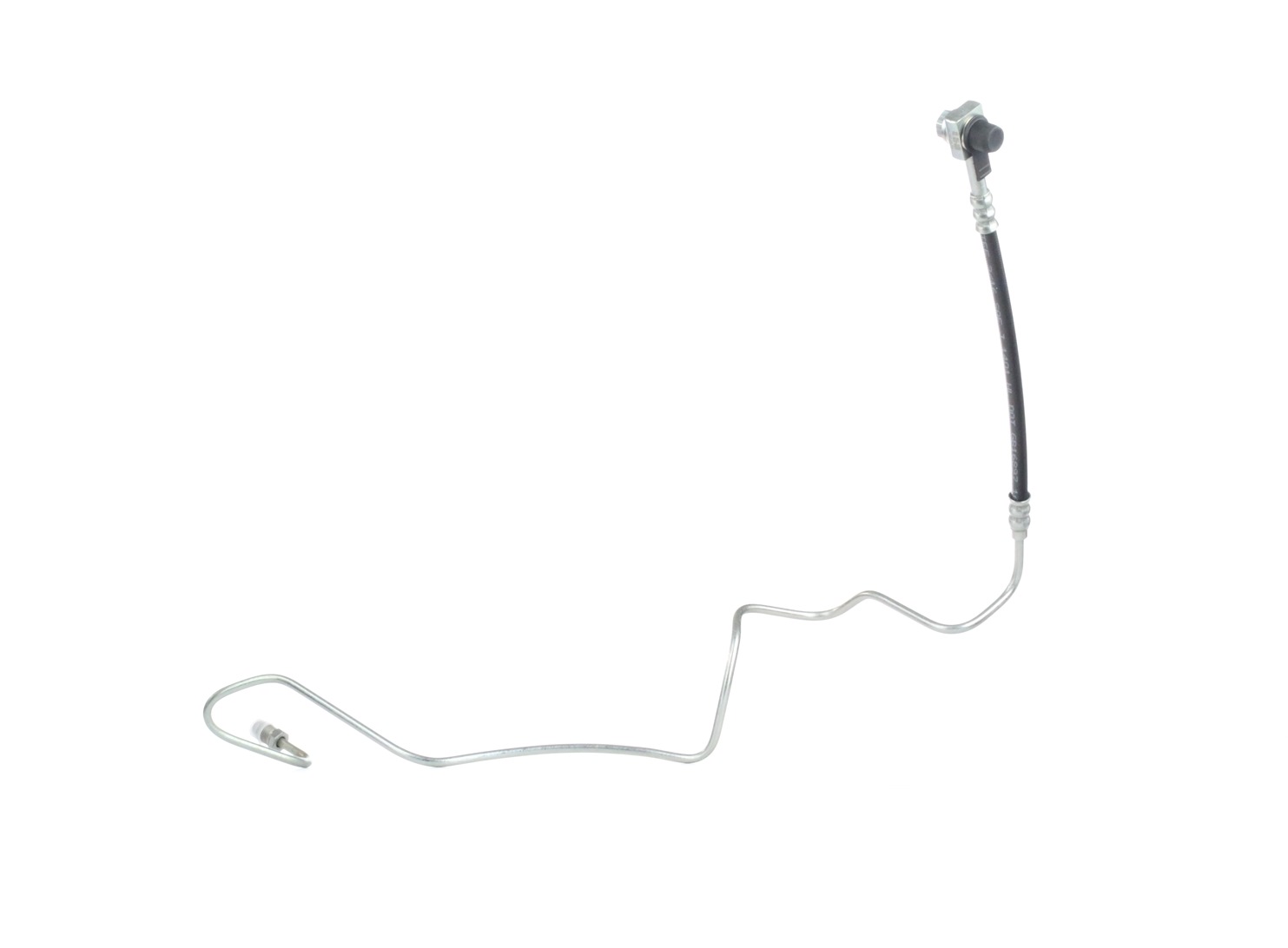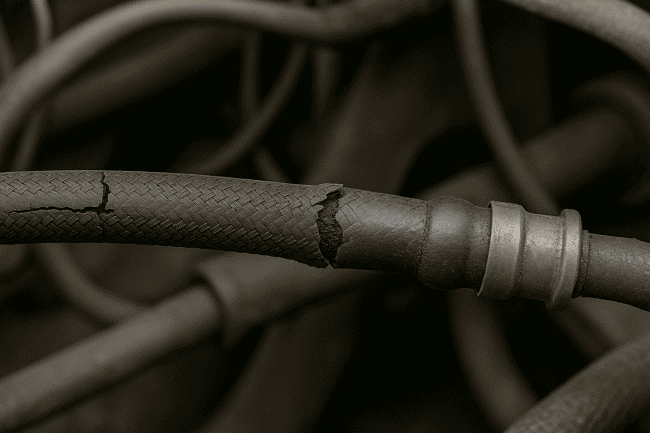Table of Contents
Car brake hose: function and failure symptoms
Your brake hoses are among the most crucial yet overlooked components of your vehicle's braking system. These flexible tubes carry pressurised brake fluid from your master cylinder to the car brake calipers at each wheel, making them essential for your ability to stop safely.
Understanding your brake system
Imagine your brake system is a hydraulic press. When you press the brake pedal, you are essentially pushing a piston in the master cylinder, which forces brake fluid through a network of lines and hoses to activate the brakes at each wheel.
Unlike the rigid metal brake lines that run through your vehicle's frame, brake hoses must be flexible to accommodate wheel movement during steering and suspension travel. This flexibility, while necessary, also makes them more vulnerable to wear and failure over time.
Brake hoses vs. brake lines: Key differences
| Component | Material | Function | Location | Flexibility |
| Brake lines | Steel/Metal | Carry fluid through vehicle frame | Protected inside vehicle body | Rigid |
| Brake hoses | Reinforced rubber | Connect lines to wheel components | Exposed near wheels | Flexible |
Both the lines and hoses are responsible for delivering the car hydraulic fluid from the system’s master cylinder to the wheel cylinders and brake calipers, thereby actuating the pistons and engaging the brakes. However, unlike the solid metal lines that run throughout the system, brake hoses are short rubber tubes that are found at the wheels and are connected to the brake lines.
The reason the long metal tubes don’t reach the wheels is that they would get damaged as the wheel turns or the vehicle drives over bumps and uneven surfaces. A brake pipe hose offers greater flexibility, allowing the wheels to move with the car’s suspension. The main downside here is that they are more prone to wear due to the hoses’ construction and location.
Sold by AUTODOC Sold by AUTODOC Sold by AUTODOC Sold by AUTODOC Sold by AUTODOC 

 ATE Brake hose
233 mm
ATE Brake hose
233 mm

 QUICK BRAKE Brake hose
860 mm, M10x1, with external thread
QUICK BRAKE Brake hose
860 mm, M10x1, with external thread
It may also be possible to install stainless steel brake hoses. These are more expensive than their rubber counterparts, but their stainless steel sheath makes them more durable, protecting the pipes against external influences, cracks and abrasion. Check and compare the range of front and rear brake hoses in our catalogue.
Sold by AUTODOC Sold by AUTODOC Sold by AUTODOC Sold by AUTODOC Sold by AUTODOC 



 BREMBO Brake hose
366 mm, F10X1
BREMBO Brake hose
366 mm, F10X1
Warning signs of brake hose failure

If there are visible signs of damage, including cracks, tears, hardened rubber, and bulging, AUTODOC mechanics recommend that you replace the parts rather than attempting to repair them yourself.
| Warning Sign | What You'll Experience | Why It Happens | Urgency Level | Action Required |
| Complete brake failure | Pedal goes to the floor with no resistance | Total brake fluid loss or system failure | CRITICAL | Stop immediately, call emergency services |
| Visible brake fluid leaks | Clear/light brown puddles under vehicle | Brake hose rupture or connection failure | CRITICAL | Stop immediately, have vehicle towed |
| Brake warning light | Dashboard warning light illuminated | Low brake fluid or system malfunction | CRITICAL | Stop driving, check brake fluid level |
| Severe pulling | Vehicle pulls hard to one side when braking | One brake completely failed or seized | CRITICAL | Stop immediately, seek professional help |
| Soft/spongy brake pedal | Pedal feels mushy or sinks toward floor | Air in brake system due to leak | HIGH | Brake inspection within 24 hours |
| Squealing or grinding brakes | Continuous noise even when not braking | Collapsed hose restricts fluid flow | HIGH | Stop driving, immediate professional help |
| Uneven braking | Car pulls to one side or feels like dragging | One brake hose blocked or leaking | HIGH | |
| Increased stopping distance | Takes longer to stop than usual | Reduced hydraulic pressure | MEDIUM | Immediate brake system check |
| Visible dose damage | Cracks, bulges, or wet spots on hoses | External damage indicates internal problems | MEDIUM | Replace affected hoses immediately |
Quick symptom checklist
- Soft or spongy brake pedal
- Brake fluid leaks (clear/light brown fluid)
- Squealing or grinding sounds
- Vehicle pulling to one side
- Increased stopping distance
- Visible cracks or bulges in hoses
- Brake warning light on dashboard
Tip: If you are an experienced DIY mechanic and decide to replace or repair your brake hose yourself, you’ll need specialised car brake repair tools, such as reset tools or bleeding and testing units.
How much does a new brake hose cost?
In the UK, you’ll usually spend between £8 and £45 on the hose itself, with prices ranging from around £8 for a basic rubber line to up to £45 for a premium or braided version. If you have a garage fit it, you’ll add roughly £40–£80 in labour costs, so expect to pay between £60 and £120 in total (dealers can push this up to around £180). Where you fall within this range depends on your car’s make, model, and year.
Conclusion
Your vehicle's brake hoses are critical safety components that channel hydraulic pressure to each brake caliper, providing reliable braking power when you need it most. For example, a robust Volvo brake hose is designed to withstand constant pressure and deliver consistent performance in challenging conditions.
Brake hoses might not get much attention during routine maintenance, but spotting the early signs of wear can go a long way in preventing serious brake issues. A quick inspection now and then, and replacing them before trouble starts, helps keep your braking system in top shape so every drive feels smooth, safe and under control.
Top products related to this topic:










